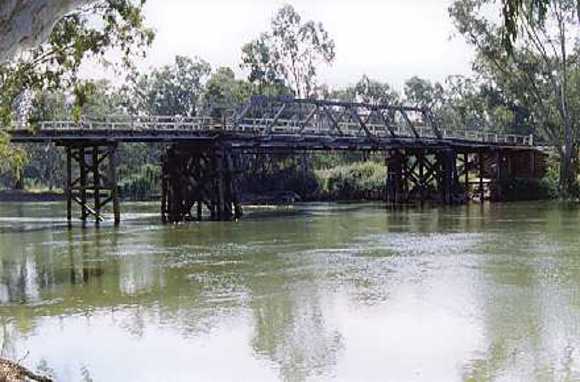| Back to search results » | Back to search page » |
|
Former Howlong Truss Bridge
LocationHowlong Road,, GOORAMADDA VIC 3685 - Property No B6803
File NumberB6803LevelDemolished/Removed |
|
Statement of Significance
The Howlong Truss Bridge is significant at State level for historical, scientific, and aesthetic reasons. From a Victorian perspective, this structure built over the Murray River in 1907-8 is the only Dare Truss bridge in which this State has invested. Within Victoria itself composite truss spans were not used, there being a straight transition from timber through-trusses of Howe type to all-steel trusses, around 1930. Although the Howlong Bridge was built to a New South Wales design under New South Wales Public Works supervision, half its cost was paid by Victoria. A few other examles of Dare Truss bridges remain in New South Wales, but this is the only one that can be approached and viewed from Victorian soil and it is an early example of the design.
The Dare Truss represented the final culmination in development of the historic American Howe-type timber truss in Australia, and probably in the world. Invented in 1840 as a railway-bridge truss, the Howe design introduced wrought iron in place of timber for vertical tension members, and has been described by American historians of engineering as the fore-runner of a new era of "iron bridges".
Percy Allan had in 1893 patented a sophisticated version of the original Howe timber-truss bridge, designed for use with Australian ironbark timber. Allan's 'Highway Bridge' design of the 1890s, widely used at New South Wales river crossings, represented a peak in development of the original American idea in its 'timber-truss' form. The Dare Truss of 1903 built on Allan's engineering ingenuity, and by replacing the complex timber bottom chord of the Allan design with rolled steel, carried the original Howe conception to its logical conclusion as a composite timber-iron-steel truss. All tension components of the truss design were now of iron or steel, whereas the large and very visible timber compression members were of sturdy Australian ironbark timber, far stronger than the softwoods originally used by Howe.
The opening of 'the Hume Bridge' in October 1908 was seen as a celebration of Australia's new nationhood. Victorians were separated from their neighbours by a blue ribbon stretched across the deck. When the ribbon was cut, once-rival 'colonials' mingled together as 'Australians'. Sir William Lyne, a prominent New South Wales politician who narrowly missed becoming Australia's first Prime Minister, was an honoured guest for the historic occasion and claimed to have persuaded Victoria's Premier to contribute half the cost of the new bridge.
The attractive geometirc pattern of Howe-type through-truss bridges was once a common sight around Victoria, but is now extremely rare. One other example on the Murray River (using the earlier Allan Truss version) can be found at Swan Hill. No examples of the composite timber and steel truss road bridge, either on the Howe model or the Pratt model, were built within Victoria. Hence the Howlong Bridge is a unique example of a composite timber-iron-steel truss bridge abutting on Victorian soil.
Situated as this bridge is, on the Murray River floodplain, the Howlong Bridge provides a now rare aestheitc experience for lovers of old timber bridges. The Murray River floodplain between Howlong and Albury is an attractive remnant of Savannah woodland landscape which is on the Register of the National Estate, and is classified by the National Trust of Australia as a floodplain landscape conservation area. The Howlong bridge is also one in an unusual sequence of New South Wales timber bridges on this road across the floodplain. (Howlong Bridges are actually in N.S.W.)
Classified: 'State' 17/06/1997
Demolished: c.2002
Group
Transport - Road
Category
Road Bridge




